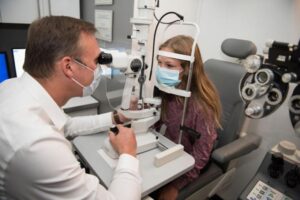Optometrists cautioning people about the dangers of increased screen time
By Dale Woodard on April 24, 2021.
 Contributed photo
More time spent in front of electronic devices such as phones and computers can lead to eye strain.
Contributed photo
More time spent in front of electronic devices such as phones and computers can lead to eye strain.With the ongoing COVID-19 pandemic increasing people’s screen time in front of computers, phones and tablets, local optometrists are cautioning people to keep an eye on the welfare of their vision.
A new survey commissioned by the Alberta Association of Optometrists found approximately 40-50 per cent of a child’s waking hours are spent on digital devices.Â
The survey also indicated 75 per cent of parents in Alberta are concerned about increased screen time and its impact on their child’s eye health.
According to recent research, excessive time spent on digital devices by children – a behaviour amplified by the current environment – can lead to digital eye strain and may even increase the risk of myopia (nearsightedness) in children.
While the pandemic continues to shutter people away and limit in-person contact, that screen time increases.
“Especially right now,” said local optometrist Dr. Maggie Gibb of Iris. “We’re doing school online and music lessons online and putting kids into these situations they’ve never been in before.”
Digital eye strain encompasses a number of factors that make it difficult on our vision, said Gibb.Â
“One is (the fact) it’s that prolonged period of time up close. So we’re staring at up-close objects for extended periods of time.”
Gibb said another factor she addresses with her patients is the brightness of the screen, making them squint more.
“The third thing that happens is we don’t blink as much,” said Gibb. “So the reduced blink rate increases our symptoms of dryness and when our eyes are drier they become more strained and our vision usually decreases.”
Shifting the focus to other areas of the body, ergonomics is another factor, said Gibb.
“Are our backs hurting or are our shoulders getting sore? When you tip your head down at that angle, I know a lot of chiropractors say it increases the weight of your head by 30 per cent. So there are a few different things that are definitely going to lead to digital eye strain.”
As a mother of two children, Gibb said she wasn’t surprised by the survey results.
As a parent, she simply aims to limit her children’s screen time.
“There are different devices on the market to limit what they’re using and their hours online, just like we would limit anything,” said Gibb. “We limit how many cookies you’re going to have and limit lots of things as parents. But a new thing we have to do a lot more these days is limit screen time and make it something that’s healthy and something that is not done before bedtime. So approach it like it’s a serious thing, that we should not be on the screen for that many hours. It’s not good for our eye development. It is linked to the progression of myopia, which is near-sightedness.”
“Myopia is linked to more severe eye disease problems, including retinal detachment and glaucoma,” said Gibb. “But it’s not the screen causes those, it’s more they cause that developmental change in nearsightedness and that nearsightedness is linked to those other problems.”
Routine eye exams also help keep tabs on signs of digital eye strain or any other potential problems.
“It’s all covered under Alberta Health Care until children turn 19-years-old,” said Gibb. “Even if they’ve seen their optometrist once that year and the parent has a concern, those types of exams where you’re experiencing headaches or eye strain, those are all covered as well, so thinking of your optometrist as a resource for that.”
Gibb said she has received a lot of referrals from family doctors regarding headaches in children more in the past year than before.
“A lot of times it’s just needing something for the lighting, controlling light, which we can use glasses for and prescribing more of a computer-type lens for the child,” she said. “When you can intervene that way it’s so much nicer for a parent than to have to think about giving kids medication. So that’s a really good first step to check out.”
Gibb said a parent might not notice a problem unless their children are squinting.
“They (children) don’t tell you they’re not seeing well,” she said. “They don’t compare themselves as much as adults because we have certain things we should be able to see. I should be able to see road signs properly while driving. We have things we’ll check each other on, where I don’t think children really put that together.
“Even with my own children I have to do a proper eye exam to determine what their error is in their vision. I don’t just know as a parent. You have to start there.”
Gibb is hopeful cases of digital eye strain come down as the pandemic subsides, allowing people to interact more in person and spend less time on digital devices.
“I would love to see children coming in with less eye strain from screen time. That would be great,” she said. “I think it’s something we have to manage in a healthy way. I don’t think we’ll ever eliminate it, but as the pandemic resolves and people are back into their more regular routine where they can be on teams and playing together and spending more of that outside time running around with their friends instead of coming home and jumping on Minecraft or their video games. I think we’ll hopefully see a lot of those symptoms go down.”
-1


